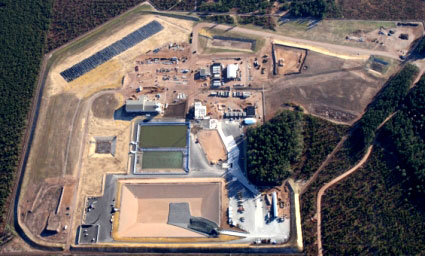Head in any direction on Michigan’s Upper Peninsula and you will reach gushing rivers, placid ponds and lakes – both Great and small.
An abundant resource, this water has nourished a small Native American community for hundreds of years. So 10 years ago, when an international mining company arrived near the shores of Lake Superior to burrow a mile under the Earth and pull metals out of ore, the Keweenaw Bay Indian Community of the Lake Superior Band of Chippewa had to stand for its rights and its water.

The Eagle Project mine is just inland from Lake Superior in the central part of Michigan’s Upper Peninsula. Credit: Michigan Department of Environmental Quality.
And now, as bulldozers raze the land and the tunnel creeps deeper, the tribe still hasn’t backed down.
“The indigenous view on water is that it is a sacred and spiritual entity,” said Jessica Koski, mining technical assistant for the Keweenaw Bay community. “Water gives us and everything on Earth life.”
The Keweenaw Bay Indians are fighting for their clean water, sacred sites and traditional way of life as Kennecott Eagle Minerals inches towards copper and nickel extraction, scheduled to begin in 2014.
Tribal leaders worry the mine will pollute ground water, the Salmon Trout River and Lake Superior, and strip the spiritual ambiance from their historical sites. Meandering through the Huron Mountains before spilling into Lake Superior, the river is home to endangered coaster trout as well as other fish that the tribe depends on for food.
The Keweenaw Bay community’s L’Anse Reservation, home to 1,030 people, is both the oldest and the largest reservation in Michigan and sits about 30 miles west of the river. The struggle of this small community in remote, sleepy northernmost Michigan mirrors that of its native ancestors.
Tribal Injustice
According to the U.S. Bureau of Indian Affairs, there are 565 recognized Native American tribes. About 5.2 million people identified themselves as Native American or Alaska Native in the 2010 U.S. Census. But that sliver of the country’s population – 1.7 percent – historically has faced an unfair burden of environmental justice issues.

Keweenaw tribe members and locals have a sunrise ceremony of prayer and drumming to protect their water on Lake Superior Day 2010. Credit: Chauncey Moran.
Since early European immigration there have been palpable culture clashes with Native Americans – with the indigenous people often on the losing end. Infectious diseases, forced assimilation and land grabs marred early relations.
But as the nation grew larger, the environmental justice issues did, too. Native American reservations have been targeted as places to dump industrial waste, and to mine both uranium and coal, leading to polluted rivers, lakes and tribal lands across the country. Some tribes have turned to waste storage or mining as revenue generators.
Native Americans continue to battle poverty, joblessness and low incomes. About 28.4 percent of American Indians and Alaska Natives – nearly twice the national rate – lived in poverty in 2010. Their unemployment hovers around 49 percent, according to the Bureau of Indian Affairs’ most recent labor force report in 2005.
Low income and environmental threats often go hand-in-hand, said Kyle Whyte, an assistant professor of philosophy at Michigan State University who studies Native American environmental justice issues.
Native Americans are even more vulnerable than other disadvantaged groups because of their reliance on natural resources for survival, he said. The top environmental justice issues still plaguing their communities are lack of healthy foods and water, and protection of sacred sites – all at play in northern Michigan.
For the 3,552 members of the Keweenaw Bay tribe, it’s more than just water at stake. “It is a living thing that provides for us – physically and spiritually,” Koski said.
Whyte said this view of water and the surrounding area is unique to tribes and should guide governance. “Part of it is admitting that some groups have a different conception of sacredness than we do,” he said.
“Almost more pure than rainfall”
The newest controversy is over the Eagle Project, an underground nickel and copper mine just west of Marquette, Mich., a few miles inland from the shores of Lake Superior. Mine development began in 2010. It is now 75 percent complete and is scheduled to operate in 2014, according to Kennecott Eagle Minerals, owner, developer and future operator of the mine. The tribe, however, hopes to derail it with pending lawsuits.
The concerns about water contamination stem from the method, sulfide mining, which extracts metals from sulfide ores. When the sulfide ores are crushed, the sulfides are exposed to air and water, which catalyzes a chemical reaction that produces highly toxic sulfuric acid. The acid can then drain into nearby rivers, lakes and ground water sources – a phenomenon called acid mine drainage.
“Water is the top environmental concern,” Koski said. “In addition to ourselves, all of the plants and wildlife rely on that water, and we have treaty rights for hunting, fishing and gathering.”
Company officials say they have addressed environmental concerns.
Any water, including rain and snow, that comes in contact with mining activities is sent to a $10-million water treatment plant that will use a cleansing technology called reverse osmosis, said Daniel Blondeau, communications and media relations advisor at Rio Tinto, the London-based mining company that owns Kennecott.
The water is then either recycled into the mining process or returned into the ground. Blondeau said mining effluent will be tested every day and results will be sent to the state monthly.
Those tasked with keeping Michigan’s water clean say they are confident that this treatment method, already used in many places to purify drinking supplies, will work.
“We actually really don’t expect a lot of water in the mine … I mean there will be some,” said Hal Fitch, director of the office of oil, gas and minerals for the Michigan Department of Environmental Quality. “Once that water goes through reverse osmosis treatment, it comes out almost more pure than rainfall … In fact, they have to have a roof over treatment plants so the treated water isn’t contaminated by rainwater.”
Experts tout the reverse osmosis and reuse as an example of technology overcoming environmental obstacles.
“The way Eagle will process the material, there will be no smelting onsite, so there’s very little likelihood for contamination,” said Klaus Schulz, a senior research geologist with the U.S. Geological Survey. “As long as they aren’t putting tailings (leftover mining material) into the streams there should be no problems.”
Tailings will be stored in an offsite temporary holding area double-lined with leak detection and collection systems, according to Kennecott officials. The tailings will also be mixed with limestone to neutralize the acid potential.
Schulz said historically mishandled tailings have been to blame for contamination.

Jessica Koski is leading the Keweenaw Bay Indian Community’s fight against the mine. Credit: Michele Bourdieu.
“The reverse osmosis is leaps and bounds over what used to happen, which was water being dumped in lakes and rivers,” Schulz said. “Plus they’ll be recycling and reutilizing the water in the process, which lessens the withdrawal.”
Western states have seen the most sulfide mine contamination, Schulz said. Two of the most well-known examples are the Summitville and Gilt Edge mines.
In the 1980s, the Summitville Mine in southwestern Colorado contaminated the Wrightman Fork tributary and the Alamosa River. The acid drainage stemmed from poor holding areas and tailing leakage. Ground water in that area is not used for drinking. But the Alamosa River below the site still cannot support aquatic life.
The Gilt Edge Mine in South Dakota was a gold mine that an insolvent company abandoned in the late 1990s, leaving behind 150 million gallons of acidic heavy-metal-laden water, as well as millions of cubic yards of acid-generating tailings. The Strawberry and Bear Butte creeks have been contaminated.
“Sure, historically there have been issues, but there are techniques today to deal with all of that,” Schulz said.
Now-shuttered Wisconsin mine
Under the Treaty of 1842, the Chippewa gave the U.S. government land bordering Lake Superior in what is now the western half of Michigan’s Upper Peninsula and northeast Wisconsin. The tribes were paid and allowed to continue hunting, fishing and gathering on the ceded land.
Kennecott now owns about 1,600 acres, including the mine site, within that territory given to the government 170 years ago. Over its seven- to eight-year lifespan, the mine will produce 300 million pounds of nickel and 250 million pounds of copper, and directly employ about 300 people, according to Kennecott estimates.
In recent years, the land surrounding Lake Superior has been a hotspot for companies seeking to mine, process and sell metals. A similar copper and nickel sulfide mine proposal in St. Louis County, Minn., by Polymet Mining, has come under similar attacks by residents concerned about the water supply.
The Eagle mine will be the first to use sulfide extraction in Michigan. The state has had copper mines in the past but it was native copper, not copper tied up in sulfide, Schulz said.
“There are no examples they can point to of sulfide mines that haven’t caused pollution,” Koski said.
But Kennecott points to its now closed Flambeau Mine that operated in Rusk County, Wis., from 1993 to 1997. Reclamation of the copper and gold mine was completed in 1999, when it was filled back in.
“We have not found any violations of mining permits or state law, have not issued any violations at the Flambeau in compliance,” said Phil Fauble, mining coordinator with the Wisconsin Department of Natural Resources.
Kennecott is responsible for the Flambeau site in perpetuity. During mine backfill and site cleanup, the company found a few areas where there was copper contamination. The company took care of the contamination right away, Fauble said. His department hasn’t yet completed studies to see if these areas could harm wildlife or people.
Emily Whittaker, executive director of the Yellow Dog Watershed Preserve, an environmental group that is also fighting the Eagle mine, said Flambeau is a reason not to trust Kennecott. She pointed to an ongoing lawsuit brought by the Wisconsin Resource Protection Council that charges Kennecott under the Clean Water Act.
Whittaker said the preparation for mining has already altered the environment in Michigan. Road widening for trucks is probably to blame for increased sedimentation of the Salmon Trout River, she said. Portions of the mine will be drilled directly below the river.
“Our main concern is the condition of the environment. Our secondary concern is the communities that depend on this environment,” Whittaker said. “Water is the lifeblood of this area.”
Hunting, fishing and blueberry gathering have already been hampered because development has gobbled up prime land, Koski said.
“Right now it’s an access issue, with the complete bulldozing,” Koski said. “If and when the mine opens, it will be pollution impacting wildlife and treaty-protected resources.”
Blondeau said the state requires the company to protect the rock’s surface and prohibits any mining activities on the rock. But to the Keweenaw Bay community, these requirements haven’t protected the rock’s essence.
“We used to drive up freely without permission or being escorted, now there is a high berm and a barbed wire fence,” Koski said. “We aren’t able to stay the night or do any traditional fasting. The whole integrity of the site is disturbed. But it is still very sacred to us.”
Fitch said that Kennecott has provided adequate access. He referred to the site as “the so-called Eagle Rock.”
“It never had that name before the project, but I guess there’s an oral tradition,” Fitch said.
It’s these kinds of communication breakdowns that are at the heart of persistent Native American environmental justice issues across the country, Whyte said.
“When a tribe expresses its own knowledge and conceptions of things like the environment to companies or officials, and it is respected, justice issues like being able to protect sacred sites and clean water are often handled in a fair way,” Whyte said.
He said the state and federal government has a mixed record on handling Native American issues, and he wasn’t so sure that this open communication was happening in the upper reaches of Michigan – especially over Eagle Rock.
“I think it’s fair to question whether the company, federal and state governments are truly respecting the unique caretaking practices of the tribe for that space,” Whyte said.
Littered with litigation
The only federal regulatory hurdle Kennecott faced was approval of the Environmental Protection Agency’s underground injection control program. After reviewing the treatment plans, the EPA determined a federal permit wasn’t necessary.
The Keweenaw community initially reached out to the EPA but did not get very far, Koski said. The EPA acknowledges that environmental justice issues persist in Native American communities, even accepting some blame.
“The environmental justice issues facing Native American communities range from direct environmental, public health, cultural and sacred sites impacts, to lack of meaningful involvement and fair treatment in the governmental decision-making processes,” according to an emailed response by the EPA’s press office.
The EPA did not comment on relations with the Keweenaw Bay Indian Community.
Fitch said the state has included the tribe every step of the way.
“They were there when we went over the rules and didn’t say much. We had meetings at the governor’s office with them and they didn’t say much,” Fitch said. “Now they come out and they’re critical, and that bothers me.”
Koski said the tribe has opposed the mine since talks began. Failing to make much progress at the state or federal level, the Keweenaw Bay community has reached out to the United Nations, meeting with James Anaya, the UN’s special rapporteur on the rights of indigenous peoples.
As the project pushes on, it remains littered with litigation.
Currently, the Keweenaw Bay Indian Community and three organizations – the National Wildlife Federation, Huron Mountain Club and Yellow Dog Watershed Preserve – are waiting to hear whether Michigan’s Court of Appeals will hear their challenge of a 2006 state permit to build the mine.
In addition, the Huron Mountain Club, a private landowners club, filed a lawsuit in April contending Kennecott didn’t get permits from the U.S. Army Corps of Engineers. The lawsuit claims that the permits are necessary since the project could harm the Salmon Trout River, wetlands, endangered species and sacred Native American sites.
So far lawsuits and knocking on government doors have proven fruitless and costly, Koski said. But the tribe will continue its steady drumbeat of opposition, pushing industry and government to respect their land, their water, their beliefs and their rights.
“An elder recently gave me a bracelet symbolizing a rainbow,” Koski said. “She said she saw that things were going to be changing.
“There is still a lot of hope.”
This story is Part 5 of a 10-part series on environmental justice from Environmental Health News. Brian Bienkowkski writes for Environmental Health News. This story is reprinted with permission from Environmental Health News, a Climate Central content partner.
Source: http://www.climatecentral.org/


